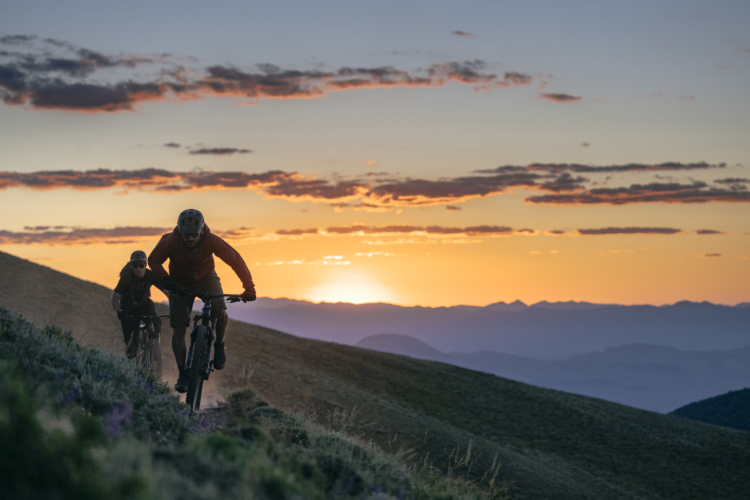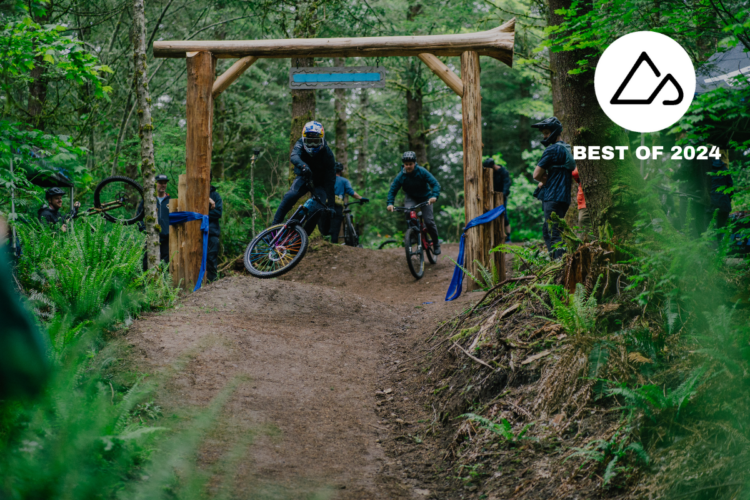
We throw a lot of virtual ink around about the latest-and-greatest mountain bikes and components, many of them measured in the thousands of dollars. And while I personally love awesome, new components and blingy carbon wheels, the facts of life usually mean that I can’t buy those types of components every day… or even every year.
Even if you or I can’t afford to drop over a grand on the latest and greatest drivetrain, that doesn’t mean there aren’t affordable upgrades available that will improve the way our bikes ride! Sometimes, paying attention to the small things can turn a worn-out bike on its last legs into the perfect steed for years to come. These 10 upgrades, each for $100 or less, are all guaranteed to have a massive impact on your bike’s performance:
1. New Mountain Bike Tires

Oftentimes, I think we take our tires for granted. Yeah, all mountain bikes have tires, my bike’s always had tires on it… I’ve never ridden a bike without tires. But since tires are the only part of the bike that touch the ground, the tires you run can make a massive difference in the way your bike performs!
There are two issues that could prompt you to buy new mountain bike tires:
1) You could have the wrong tires for your local trails and the conditions you ride. Oftentimes, the tires that come stock on a mountain bike are cheap (lower cost for the bike company) and are halfway decent for average trail conditions. However, there’s really no such thing as “average” trails: soil composition, moisture level, and many other variables vary wildly from place to place. Maybe your stock mountain bike tires will work well for you, but maybe they won’t. If you don’t have the right tread and rubber compounds for your area, it’s time to upgrade.
2) You could have worn down your tread significantly. Many times, I don’t really realize how worn my tread actually is; it’s not like it changes rapidly enough to notice it. However, when you place a worn mountain bike tire next to a brand new tire, you’ll see the wear… and when you finally get new rubber on your steed, you’ll notice the performance improvement!
Note: you can easily spend more than $100 on a pair of mountain bike tires, but if you shop closeouts online and aren’t committed to buying the lightest tires, you should be able to re-shoe your bike for less than 100 bones.
2. Go Tubeless

I fought going tubeless for the longest time, but after moving to Colorado I had little choice: the combination of goat heads, cacti, and sharp rocks is lethal to tubes. However, after a relatively quick, painless, and affordable transition, I haven’t had a single flat with my new tubeless setup! Also, the traction benefits from lower pressure as well as the overall weight reduction are reason enough to switch. Yeah, I’m a believer.
3. New Mountain Bike Grips

As a general rule, some of the most important components on your mountain bike are the contact points–IE, where your body contacts the bike. Also, the tires mentioned in #1 and #2 contact the ground, so they’re vitally important as well. However, these contact points are often overlooked when shopping for and upgrading a bike, even though they aren’t expensive.
The right pair of grips for your hands and your riding style can make a world of difference. Often this comes down to personal preference, so I recommend you try out a few different types, but at roughly $30 for even really nice mountain bike grips, this is a pretty affordable upgrade.
For cross country riders, I personally recommend Ergon grips for weight distribution and comfort. However, if you’re into technical descending, a round grip is better–Oury grips offer great padding in a round form, but they’re definitely thick. Thinner round grips are plentiful. Im adding this
4. New Mountain Bike Pedals and/or Cleats

Whether you ride clipless or flats, mountain bike pedals, like any other part of the bike, can wear out. As a contact point, they are very important, but are again often overlooked. However, you can easily get caught spending more than $100 on your new pedals, but if you’re willing to sacrifice a few grams, you can score new ones for well under $100. Be sure to check out the Shimano Saint MX80 Reviews.
If you buy new clipless pedals, cleats will be included, so be sure to replace the ones on your shoes. However, sometimes all that’s required to make a set of old pedals feel new is simply replacing your worn-out cleats.
5. New Mountain Bike Saddle

Saddles are a very personal component–the saddle that came stock on your mountain bike might fit you perfectly, it might fit you reasonably well, or it may just not be the right size/shape for your anatomy. Finding a saddle that fits properly can make a world of difference, and if you’re willing to buy the budget-friendly model that’s a few grams heavier, many comfortable saddles can be had for less than $100.
6. New Mountain Bike Stem

If you thought mountain bike stems were just for bike-fitting purposes, think again. A shorter mountain bike stem brings down your overall reach so that you’re able to get quicker response and better control over the front end of the bike. Many downhill bikes will have a super short 40-50mm stem and mountain bike stems on trail bikes often range between 60-80mm; cross-country bikes typically have stems in the 100-120mm range. Depending what kind of riding you do, you should have no problem finding the right length stem under $100 but expect to pay more for carbon (as usual!).
7. New Mountain Bike Handlebars

Just like changing out your stock stem, replacing your stock bars can also affect the control and maneuverability of your mountain bike. Some handlebars are better suited for riding disciplines so aside from price, you’ll want to consider things like bar width, clamp diameter, rise and sweep. For specific mountain bike handlebar recommendations, check out our mountain bike handlebar reviews.
8. Mountain Bike Chainguide

Do you really need a chainguide? Not necessarily, but if you find yourself constantly stopping trailside to fiddle with your dropped chain… again… then this small contraption could save you a lot of frustration. Try a handy low profile, direct mount chainguide like this one from Oneup Components and say goodbye to dropped chains.
9. Larger Front Rotor

I’ve often been discouraged by the stopping power of stock cross country bikes. What’s the issue? Do I need to buy a new set of brakes? New pads? What? Well, I’ve found that a simple increase in the size of the front rotor is an affordable, yet very effective, way to increase stopping power. If you buy a cheap rotor and spacer kit, this instantaneous power upgrade is well under $100.
10. Get a Tune Up

There are so many ways that a mountain bike can deteriorate that it’s a little depressing, but if you’re truly addicted, what can you do? Well, one of the best ways you can invest your money is to keep on top of standard mountain bike maintenance.
In addition to getting a full-blown tune up by a professional (which may be under $100, or may not), here are different components where a little maintenance can mean a big change in performance:
-Cables and Cable Housing: This seems to be a common story with me: I’ll be riding along, wondering why my bike shifts like crap, and I’ll realize that I haven’t had the cables and housing replaced in maybe two years. After a quick trip to the shop and about $30, my bike is shifting and riding like new! Don’t overestimate the value of a smooth-shifting bike
-Brakes: A quick brake bleed can sometimes do wonders for your brake performance! Also, a new set of pads can sometime make a big difference.
-Suspension: Make sure to keep up with the regular maintenance on your fork and shock (if applicable). If you neglect that maintenance and are wondering why your suspension feels like crap… that’s probably the reason.
-Bottom Bracket: Bottom brackets need to be cleaned and greased on a regular basis, and if you neglect that maintenance, you’ll soon be able to tell from the grinding and groaning every time you pedal.
These are just a few suggestions for affordable upgrades that can really improve in how your mountain bike performs. What low-cost upgrades are you a fan of?











20 Comments
Mar 31, 2014
Dec 4, 2014
Jan 1, 2018
Apr 3, 2014
Jul 20, 2014
I'd like roo give honorable mention to dropper posts. Mine was$138 ks budget model from Arts'. 100 mm drop and infinite variable, that's a huge deal to me for short$
Dec 3, 2014
Mar 31, 2014
Jan 6, 2017
35mm is on the dot with mine, and although dropping the length brought all the improvements..40mm was the way to go.
Also check some of the cheaper brands from places like Korea, mid level prices with top level components is hard to knock.
Dec 21, 2017
Apr 1, 2014
I've done all but #5 (love my stock saddle though) and the bike came with 7, 8, and 9.
Getting new tires/going tubeless was nice, but I think the new stem/wider handlebars made the bike feel way more lively!
Jul 20, 2014
Dec 3, 2014
Mar 31, 2014
Mar 31, 2014
Mar 31, 2014
Mar 31, 2014
My Wet combo is 2,3 weirwolf front and 2,3 bronson rear.
My dry combo is 2,3 weirwolf front and 2,1 monorail rear.
All great tires that i would buy again. I might be looking for a rear racing tire that can handle both dry and wet conditions
Mar 31, 2014
May 3, 2016
http://fcdn.mtbr.com/attachments/bike-frame-discussion/981508d1429130720-broken-carbon-fork-while-braking-broken_carbon_fork_close.jpg
I have 180 mm front brakes and haven't found them to be a problem personally, but I guess you might want 200+ if you are riding long DH tracks. But in that case you should really be careful not to break the fork, so yeah, read up on it.
Mar 31, 2014
Mar 31, 2014